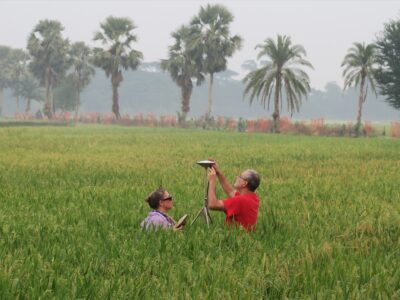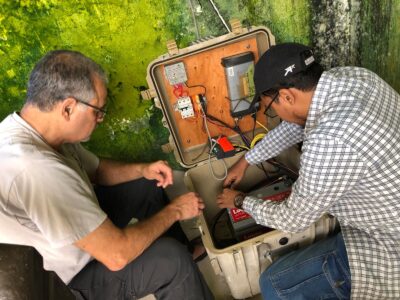
We left the pleasant house in Kushtia to resume our nomadic existence. We spent a full day driving to northern Bangladesh. We will now work our way downstream stopping at multiple places along the Brahmaputra River. Finding little traffic, we drove past Rangpur, where we will be staying to the Tista River, a tributary of the Brahmaputra. While it is a large river during the summer monsoon, today it was a shallow stream with exposed sandbanks and people growing crops in the middle of the channel. Chris decided the hour we had before sunset was enough time, so we climbed down the embankment and hired a boat to cross the river. It was shallow enough that we saw children wading across and Chris got out and walked the rest of the way, followed by the chidren. Water diversion projects upstream means

there is little water here in the winter. Some exploration, some sampling, some photos and we were done.
We were up early for the long drive to the Brahmaputra. We hadn’t planned on coming this far north, so we didn’t have maps of this years arrangement of the river. I found two possible places for boat hires and ended up choosing Chilmari as the place easiest to get a boat. When we got the to river agound 11am, we found a cliff. Apparently ~1 mile of the coast had eroded here. An old woman chastised us that we should either prevent the bank erosion or give them money so they could move. We learned the boats were a few hundred meters upstream where you could walk down to the water’s edge. Along the way we

passed a group digging up the topsoil along the cliff to sell before it toppled into the river. We could see the cracks where the next pieces of land would be lost.
We bought some snacks for lunch and hired a boat. The fist char (sandy island) was unnamed, but 5 families from Bazradiarkhata Char had settled the north end and started farming, growing squash, wheat and dal. The char was only 5-6 years old. The families still returned to the larger char in the summer and New Bazradiarkhata Char, as we called it, was chest deep in water during the summer. We continued north to Kachkol Char. This char was 8-10 years old. However, it was now attached to Bazradiarkhata Char. The corn, wheat, dal, etc. growing was being farmed by

people from Bazradiarkhata Char. The village we visited were people who only moved there 6 months ago when their village and land on a char was claimed by the river. They were working a paid laborers and did not have their own land to farm. They were concerned that Meredith be careful of the sun so she wouldn’t get burned. They also suggested that if she moved to the char, she could get dark like them. We then went downstream to Bazradiarkhata Char itself. This char was formed during the major 1988 flood when 2/3 of Bangladesh was submerged. Now, 25 years later it had lots of trees homes, crops, an elementary school and an adult education center. We were surrounded by children, particularly Meredith. She could get the girls to pose for her,

but I could not. On the side of the village, there were great sedimentary features and Meredith and I measured a channel for some flow calculations. At all of there sites Chris sampled and documented the sediments and vegetation cover. By now it was getting late, so we left and circled the downstream end of New Bazradiarkhata Char. Newer and still unpopulated, the cut banks showed amazing patterns of crossbedding from the migration of the sand waves that built the char during high water. We explored this end of the char as the sun set over the right bank of the Brahmaputra.
Today, February 21st, is Language Day commemorating the 1952 martyrdom of students protesting Pakistan’s law making “Urdu and only

Urdu the language of Pakistan” when the Pakistan army opened fire. The ultimately successful language movement in the 1950s marked the beginning of the path toward independence. On our drive to Gaibanda, we saw numerous troups of school children heading to their local Shahid Minar, language day memorial, to pay their respects and drop off flowers. In Dhaka people laid numerous fantastic decorations made of flowers.
Gaibanda was the opposite of Chilamari. Here the coastline has grown outward and we had to walk out to the docks. We later discovered that the new land filled in what was the channel we crossed to reach Rosulpur Char in 2005. It is now attached to the mainland. The embayment by the coast is all that is left of the channel. Humayun again hired

a boat and we went south to an area where Chris could see numerous color variations on the satellite image. We found the land has changed substantially from the image of early January. The channel we wanted was too shallow for the boat, so we had a very long walk. A new Landsat image to be acquired tomorrow should be close to what we saw. Where we stopped was Manikkor Char, only 6 years old. The tree covered area to the north was Kashkhali Char, which is 13 years old. We walked towards it and met a farmer. He told us that there was a town and bazaar here 30-40 years ago, but it was lost to the river. When it returned he received land because his grandfather had owned land here. Such is life on the ephemeral chars. We continued walking towards Kashkhali, but wanted to cross to another area. Only Chris

and I walked through the muddy shallow waters of the embayment. In this area, which we called New Kashkhali Char, we met another farmer, but had no translator. Still, he helped us sample.
After finishing sampling, we went north to Rosulpur char that we visited in 2005. We showed the people photos on my iPad, but found that most of our photos were of people who resided there only temporarily due to their land being lost. They now lived across the channel to the east. Still we were welcomed and follow by lots of children and a few people remembered us from 2005. The teacher remembered Chris, but wasn’t sure about me. Overall, the village seems to be doing well with lots of corn growing on the char. We ended early, but then had a long drive to Bogra for our hotel.






